How Can I Get Clients For My Interior Design Business

By DAWN-MARIE NESBITT
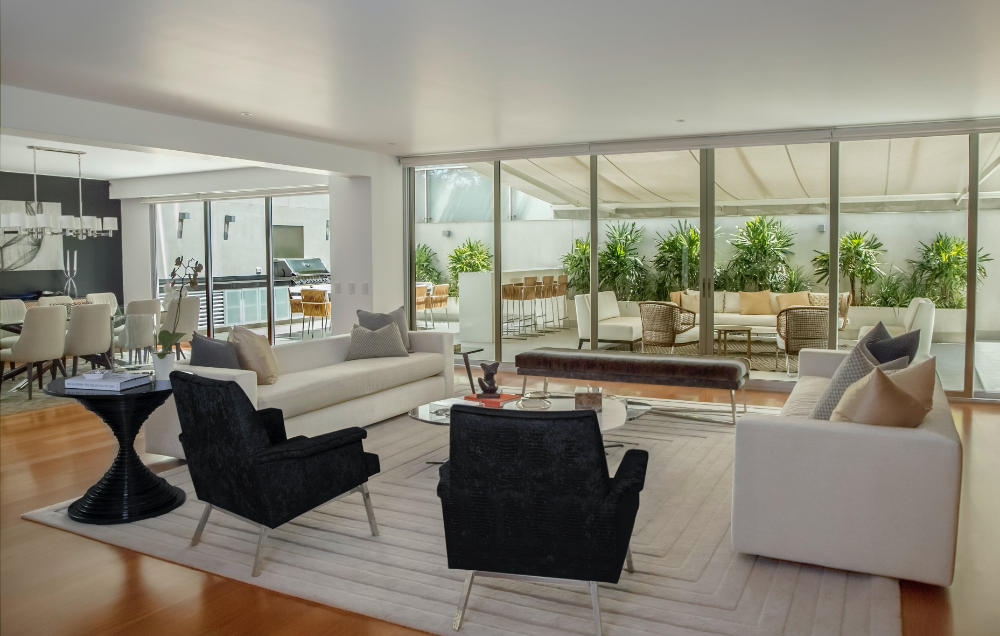
As a start up, you’ve decided that you want to start an interior design business, but once you’ve made that decision, what’s next?
How can you get clients for your interior design business?
How do you actually get your first client?
I was inspired to write this blog post after watching Karin Bohn from House of Bohn, an interior designer for the past ten years, who shares entrepreneurial advice to female interior designers and entrepreneurs on her YouTube channel.
I scrolled all the way back to watch her very first vlogs and saw that she shared some amazing gems on how to win clients for an interior design business. Together with her little nuggets and my own knowledge as a marketing consultant, I want to share with you some perfect ways for getting clients for your interior design business.
Here’s what you will learn:
- Expectations to have as a start-up interior design business
- First things to do when you don’t have a portfolio as an interior design start-up
- Quick ways to get clients for your interior design business
- Other ways to get clients for your interior design business
- Building a sustainable interior design business
Expectations to have as a start-up interior design business
First of all be prepared for the long game. Like any start-up, it’s not going to be a bed of roses especially when you don’t have a portfolio of work and don’t have client testimonials to act as your social proof.
I know for me, starting as a marketing consultant and landing my first client, I did not have any case studies of my work, but what made me attractive to my clients was how I marketed my value.
I wrote blog posts about marketing and strategies on my personal blog, I Am Dawn-Marie and was able to demonstrate my expertise by showing potential clients my thought process for how I would execute one of their campaigns.
It was this confidence that led me to securing my first clients.
In entrepreneurship and as an interior designer start-up, expect that there will be gaps in the time when you have projects to work on. According to Karin Bohn, if you can handle the lulls when you don’t have projects or the fluctuations in cash flow then you can survive entrepreneurship.
If you can’t do this, then entrepreneurship may not be for you.
Karin says that “your next project is definitely not on the heels of your last project.” It is a myth that once you have landed your first interior design project, that the next one is right around the corner.
This isn’t exactly true for most interior designers. Karin says that her first interior design project was designing a small restaurant powder room and she thought that upon finishing it, that someone would see her project, the phones would ring to tell her how great she was and asking if she would work on their next project.
This was not her reality. In fact she had to hunt for business and it took her three months to secure her next project.
Many interior design start-ups are not prepared for this and give up too early causing them to fail.
Expect breaks in between your projects but don’t ever give up on finding your first or next client when you’re just getting started.
Now that you know the mindset you need to have, here are some things you can do as an interior design start-up when you don’t yet have a portfolio and how you can market your value to prepare yourself for your first client.
First things to do when you don’t have a portfolio as an interior design start-up
Your Website
You might be asking yourself should I have a website? Should I set up social media accounts?
Let’s talk about that website first of all.
It’s important, because if you want people to connect with you and potentially hire you as an interior design start up, you have to believe that they’re going to do research on you.
When they do research, you want them to find information about you and you can host this on your website.
This does not mean however, that you need to spend thousands of dollars designing your first website, just to make a good first impression. (Want to know the real cost of designing a website? Check out my blog post here.)
Not at all. All you need is a website that’s good enough, that showcases your own creativity so you can convey to the website visitor that you are great with creative projects.
On your website include
- Your story and journey
- Your values
- What makes you different
- Helpful content that solves the problems of your ideal client
Your website is not only going to act as your online business card, but it’s also going to be the place that will help you get found through local Google searches when your ideal clients are searching “interior designer near me”.
For this reason, make sure that your website is search engine optimised and has content that answers the questions of what your ideal clients are asking or has content written around those keywords or key phrases that you know your ideal clients are searching for (see more about this later in the post).
Free "Build Your Own Website" Toolkit
Click to get access to your own website toolkit and build and design your own website with WordPress in as little as a weekend.
Your Social Media
On to social media.
Should you be creating social media accounts and focusing on building them up?
Karin Bohn said something interesting in an interview she did very early on, on her YouTube channel.
She said that the people who follow her on her YouTube channel, Instagram and Facebook are a completely different type of audience from her actual clients.
She has found that her social media followers are those who are asking the question “how can I start a business?” as opposed to “how can I work with you?”
As an interior design start-up, starting social media accounts, will definitely help you build brand awareness and build an audience of people who like you and follow your journey, but it may not be the source of your first client.
So based on this alone, don’t spend too much time investing in starting social media accounts.
Karin actually started her YouTube channel eight years after starting her business. Her Instagram account was created approximately 3 years into her interior design business.
So what does this tell you?
It means that you don’t need these things to actually start getting your first clients and even if you do decide to start a social media account, it will be a very steep and slow climb to make because it will take time to build awareness and get visibility.
Plus remember what Karin said. Your clients may not even come from social media. Instead you might be attracting people who have very small budgets or are just looking for advice on getting started as well.
But I’m not saying to dismiss social media altogether. This is something that you can focus on from time to time to build brand awareness, but as an interior design startup see social media as a long term strategy to build a community and make an impact on people who would one day want to be just like you.
Quick ways to get clients for your interior design business
With social media and your website out of the way, one of the most instrumental pieces of advice that I have learnt from my mentors, is that when you’re just getting started as a service provider, nothing else matters than what you do to get sales.
Therefore building a website, coming up with a logo, creating content. All of that does not matter right now.
As Karin Bohn said in her Q&A video published three years ago, your focus has to be on sales and getting your first client. Once you have done that successfully, then you can focus on the secondary things.
The next few paragraphs, share some ideas that you can implement to get clients right now. Once you have some clients and if you want to expand your reach to the online marketplace, I’ve also included some strategies that you can adopt to build an online brand.
Word of Mouth Marketing
When you don’t yet have a portfolio, the best way to market your value and position yourself is to build relationships through word of mouth.
The quickest way to land your first client is reaching out to contacts that already know you and ask for a referral.
Why is this important? Because the people who are in your circle, already know you, like you and trust you and can vouch for your professionalism and competency.
They are the best people to advertise your services and it’s more than likely that the people who they speak to, will come from a place of already trusting you, just because they received the recommendation from a trusted source.
Referral sources can be:
- Close friends and family who have professional networks
- Your professional circle – vendors, affiliate partners
Even though referrals are a slow method and sometimes the referral may not materialise into a client, once you have formed those relationships with your referral source, Karin says that you can encourage these sources to be your “champions” so they’re always inspired to mention your name or keep you top of mind in their network.
A great way of building stronger relationships even further is to send hand-written notes thanking them for any referrals they send. You can also send flowers or cupcakes as thank you’s. These small gestures go a long way to making you a memorable name and someone who they will have no problem in going the extra mile to talk about your brand to their network.
Collaborations
If your potential client is paying attention to a complimentary industry expert, can you partner or establish a relationship with that expert? Maybe yes?
Think about estate agents who are helping new homeowners or rental property investors buy their first rental properties. How can you connect with them and offer your expertise on designing these spaces?
What about building contractors who are building commercial or residential spaces – think show homes. Connect with them and see what kind of partnership you can create that motivates them to mention your name to their clients.
If you think that these relationships are too big, what about smaller projects with landlords who may want to redesign short lets or rental spaces?
Wardrobe or kitchen design companies may have a design service or complimentary service for their own clients. Reach out to the managers of these companies and start connecting with them and offering value.
Are there any designers, craftsmen or curtain or blind makers that you know of that you can collaborate with? It’s more than likely that they would already have an audience that they engage with. Ask to work with them in an interview or article where you can create content that they can then share with their audience.
The benefit of this, is that they don’t have to create the content themselves and have someone doing it for them that adds value to their audience. When you do this, you are able to borrow their network and get your name in front of people who are in your circle of ideal clients.
Networking
Go out into the market and find events where you can share your value to audiences. Volunteer for discussions at interior design events. Look at your local chamber of commerce and see if there are any networking events specific to interior design that you can speak at. When you put yourself out there you are able to build your authority and start getting your name on the lips of industry experts. You might even get some press coverage as well.
Where do you find these events? Google “interior design conferences near me” or “interior design exhibitions near me”. Find the co-ordinator of the events and email them asking how you can contribute to the event.
From my own experience, it’s not best to pitch how great you are. Rather focus on the value that you can contribute and how you can help the exhibition increase its worth to the people that are investing in it.
As Karin Bohn said, when you’re just getting started “you always have to be going out there … you have to be picking up the phone and connecting with people and you have to be introducing yourself and you always have to be finding opportunities where you can work with people. You always have to be selling”
As for networking events, she also said something which I feel is so important for beginners to understand.
Yes you want your first client but your focus should be on building relationships. Don’t expect that when you meet new people or go to these networking events, that you will find people who need an interior designer right now.
It may happen but it’s very unlikely. Karin said that when she got started, she went with the mindset of “building relationships for years out”. It was never about showing your portfolio then getting immediate business.
She said that sometimes it took two, three or four years before she started working with the client but she always continued to build the relationship and overtime developed a pipeline of trusted contacts. You have to plant the seeds for the future.
Pick up the phone
Another really good idea which I feel not everyone is keen on doing because of the fear of rejection (I know, I had that fear when I first started my agency), is just picking up the phone and having a conversation with people.
Cold calling may be outdated because of all the online marketing techniques available, but according to Karin, this is how she started getting sales in her business.
She says in her Q&A video, that if she knows of a restaurant group that she wants to work with or a builder, developer or architect, she will pick up the phone and start making those connections.
If you do use this strategy, you may have the mindset that you’re begging for work when in fact you have to see it as you having an expertise that will greatly benefit the person you’re speaking with.
When I rebranded in my agency and did cold calls to get clients, I had to shift my mindset from thinking that I am bothering someone to thinking that I have a great set of skills that will likely benefit and be an asset to the person that I am talking to.
When I do that, I no longer feel intimidated and actually more confident in my ability to deliver a sales call without sounding too salesy or desperate.
As you do these sales calls, remember that the connections are your way of planting seeds. I think these days with so much hype on the internet, everyone gauges their success by how quickly they can land their first client.
And I’m not surprised with so many “experts” saying you can get a client within your first month and setting the wrong expectations.
I love Karin’s long-game mindset and it’s one of the mindsets that I had to adopt when I rebranded my digital marketing agency. I had to remind myself to slow down and get ready to build consistently.
Other ways to get clients for your interior design business
So let’s say that you hate the idea of cold calling or networking and these break you out in a sweat or have you palpitating before you even get started.
Don’t worry. I know exactly how you feel because cold calls made me feel really uncomfortable and networking events took up a lot of my time.
But whilst these methods do work and as Karin said it’s all about getting your name out there and starting to foster relationships so you can fill your funnel, you may want a hands-off approach to prospecting and filling up your lead pipeline.
Here are a few ways you can do that:
Use Google Methods Like SEO and Google My Business
There are many people who are super introverts and would rather sit behind the computer and get people to know about them.
The good news is, whilst it’s not the quickest way to landing your first client, it’s a working method to get your name out there but it will take time.
It may take months before you even get found but if you start now, it can open so many doors and opportunities later on, whilst you focus on the more direct methods that I mentioned above.
As an interior designer, Google allows you to create a Google My Business (GMB) listing that helps your business get found locally.
So if someone is searching for “Leeds interior designer”, as long as you have optimised your GMB listing effectively, you can rank as one of the results in the search engine.
Here’s how that looks:
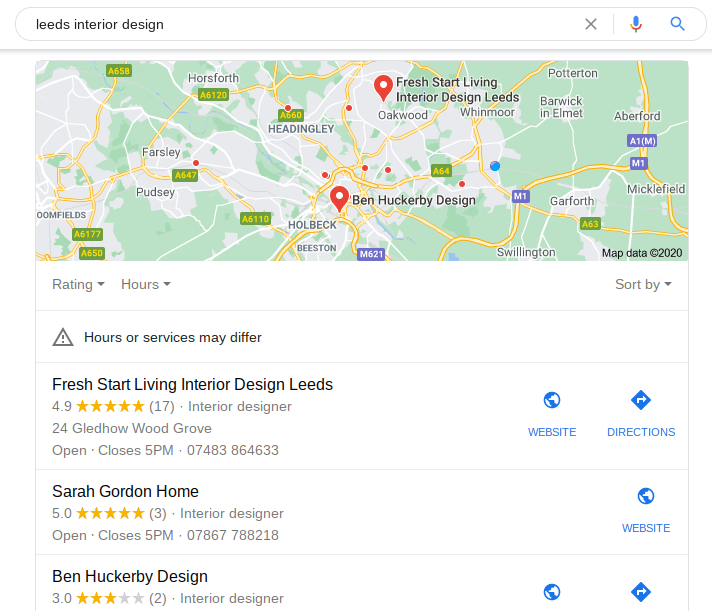
GMB is a free tool and allows you to manage how your business appears in the search results and on Google Maps.
With a GMB listing you can add your business name, location, your working hours, website and manage reviews and photos in your account.
Some people create a GMB listing and leave it untouched without doing anything further to it once created.
GMB created this free tool to allow you to interact and engage with your potential clients so be sure to always update your listing with photographs or important information that your prospects will find helpful. You can also use the GMB app to post status updates which is handy to let prospects know that it’s an active listing.
SEO
Search engine optimisation is typically daunting for most people because they feel that it’s too technical.
Actually SEO can be a simple strategy you apply to your business website in order to help your website get found in the search engine by people who are searching for your services.
When I started my blog back in 2017, I told myself that there was no way I was going to do anything with SEO. And even though I never specifically paid attention to SEO, I found that overtime my blog got found in the Google search results and people were reaching out to me asking to work with me.
So don’t overlook the power of having a website that is search engine optimised.
If you want to use SEO as a long-term strategy, consider building your website with WordPress. That’s because WordPress gives you room to grow and provides useful plugins that help you with SEO as well, such as Yoast SEO.
I would not recommend website builders like Wix or SquareSpace because you have no complete authority over your website since you are renting the use of these platforms and they can suspend your website at any time.
You also have very limited features and customisation on Wix or SquareSpace to help you build a really professional site optimised for SEO.
Free "Build Your Own Website" Toolkit
Click to get access to your own website toolkit and build and design your own website with WordPress in as little as a weekend.
Once you have your website designed, the first thing to do to get started with SEO, is understanding exactly what your ideal clients are searching for.
Ask yourself, “what will they type in the search engine to find my business”.
You want to think about phrases or sentences they are using when the prospect is in the frame of mind to use a service.
For example, if someone wants to hire an interior designer, they might type “hire interior designer near me”.
If someone is looking for the services of an interior designer, they might type “interior design services near me”.
If you provide a very niche interior design service, then consider the specificity of the search. For example a restaurant owner might search for “interior designers who design restaurants”.
The key to using the right keywords during your research is to really get in the minds of the searchers and thinking about what they’re thinking as they type and are looking for someone to do business with.
Once you have come up with a couple keywords and keyphrases use Google’s Keyword planner tool to see how many people on average are searching for them each month.
Google’s Keyword planner tool is only available in a Google Ad account so you must sign up for Google ads and then access the tool from within your account.
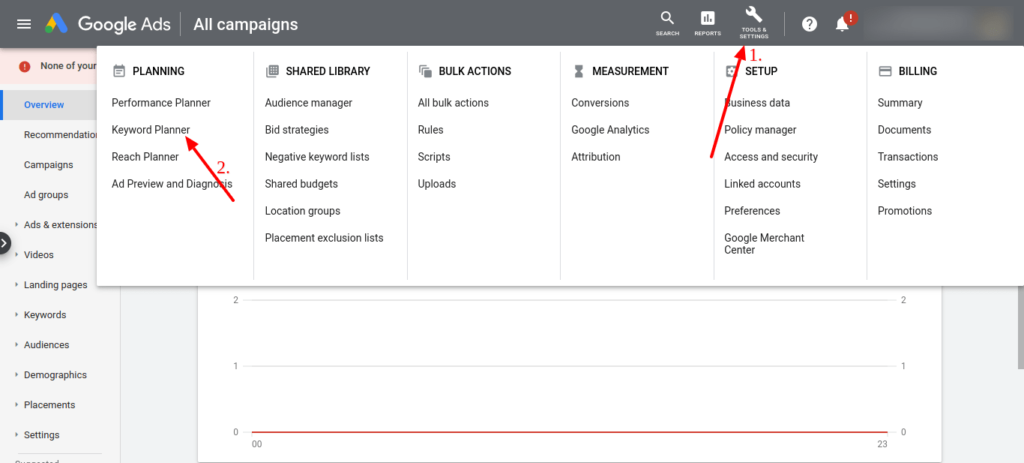
When you get there, click on Discover new keywords.
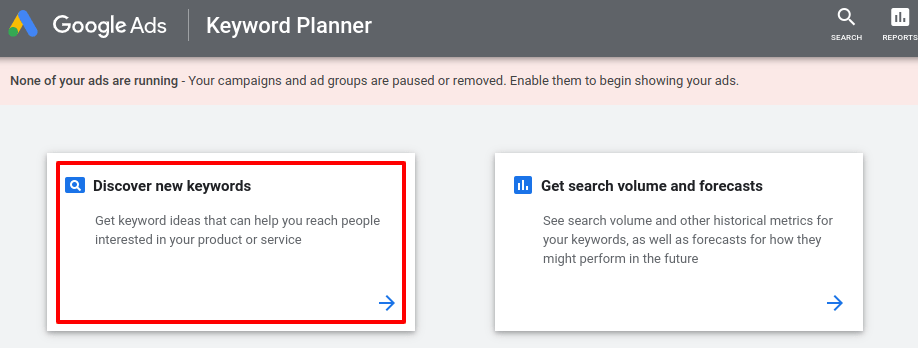
Enter your keyword or keyphrase like I have done below, then click get results.
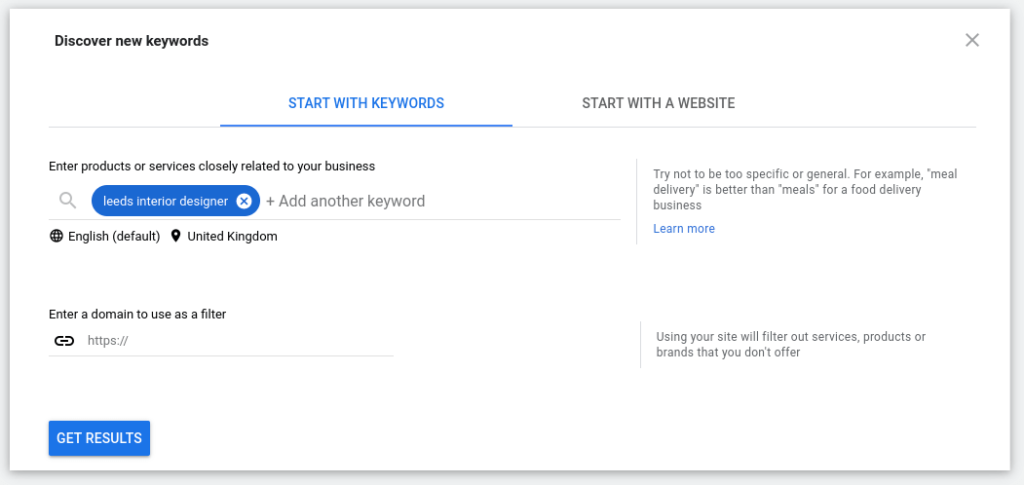
Google will show you the volume of searches for the particular keyword you have entered, including additional keywords that you might be interested in, to help you expand your search.
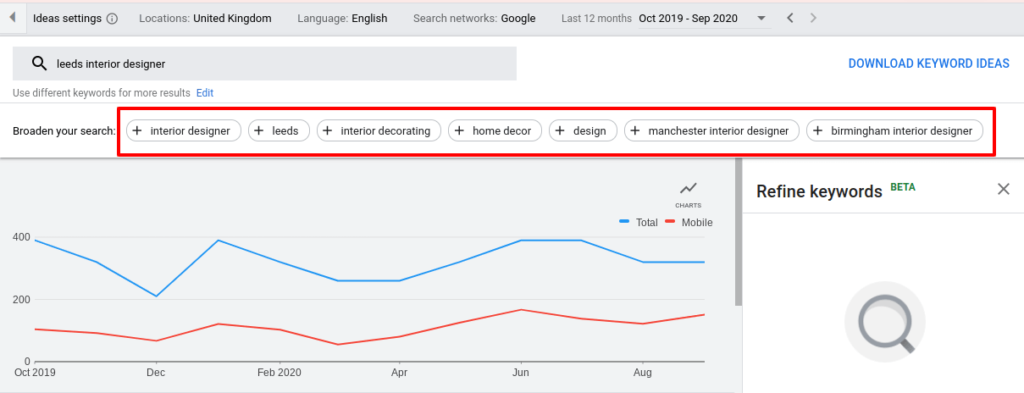
When you scroll down on the page you can see the number of average searches per month. If the number of average searches is more than 50 (the benchmark that I use to determine whether I would focus my content on that keyword), then you can use it on your website to help you optimise it for that keyword.
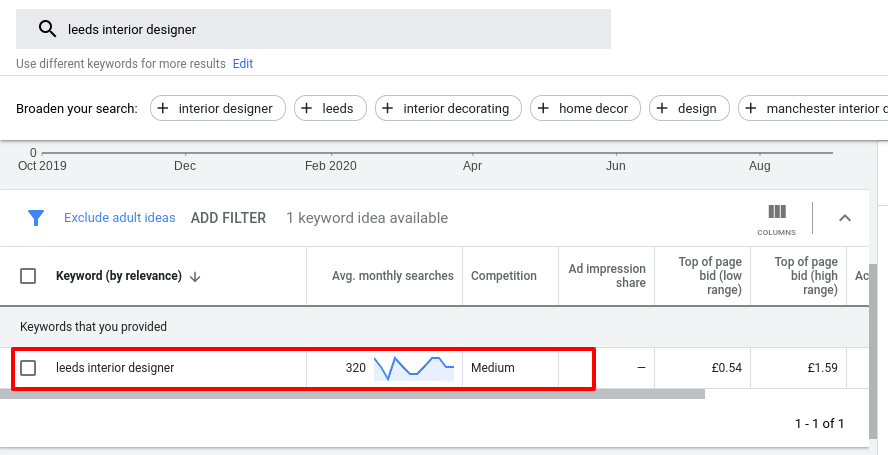
When using this keyword on your website, you can perform on-page SEO which means improving a webpage for a targeted keyword.
Use the keyword in your
- Titles
- Header tags like H1, H2, H3 etc
- Alt tags
- URL slugs
- Meta descriptions
- Page content
Doing this alone does not make you more likely to get your page ranked on the first page of Google. There are a number of factors that Google takes into account, but this is a start that you can consistently work on to improve your website for the search engines.
Build Your Authority With Blogging
On the topic of SEO, blogging is a great way to build your authority as an interior designer by having a home on the internet to share your ideas and offer expert advice on the problems that your ideal clients are experiencing.
Your blog can be on your website and consist of articles that you know your ideal clients are searching for, where they need answers.
It’s more than likely that other interior designers are not using blogging as a marketing strategy. This is where you have the opportunity to stand out and get found by people who have problems with interior design and need a solution.
How do you do that?
You create content based on the questions that people want answered and you can get a lot of data about this from Google itself.
Let’s say that you help AirBnB sellers design their homes so they can increase their chance of successfully selling a listing.
When you go to Google, you can easily see what AirBnB sellers are typing in relation to design by using the keyword “how to design my AirBnB”.

As long as this keyphrase gets an adequate number of searches per month, determined by using the Google Keyword Planner tool to see the volume, you can then create content around this keyword to answer the question.
Once content is created be sure to use the keyword in the following places as well:
- Titles
- Header tags like H1, H2, H3 etc
- Alt tags
- URL slugs
- Meta descriptions
Don’t forget to promote the content on your social media, with other interior design enthusiasts or bloggers so you can get the word out about your article.
Use Instagram
I’m saving the best for last because I feel that Instagram will be a powerful way for you to get in front of potential clients who want your services.
Instagram is a visual platform and for this reason alone, it is the preferred choice for interior designers. There’s also Pinterest but Instagram gets a lot more traffic and really allows you to connect with the people that matter to your business through hashtags, IG Live, IGTV and IG Stories, Reels and even the direct messenger.
Karin Bohn did say that she does not get clients from social media, but Instagram can be a place where you connect with brands or open up PR opportunities that give you a platform to be found by your potential clients.
If you are using Instagram as a marketing strategy, whilst posts will help you create a visual feed and show off your ideas and creations, the other tools like IG Live, IG TV, IG Stories and Reels are what will help you engage with and really connect with your audience on a human level so they can interact with you and get to know you better.
If you don’t know where to start Montelle’s Brand Your Influence Instagram Course helps creative entrepreneurs use Instagram to build and monetise their brand.
Check it out as it gives you all the strategies and techniques that are working today to help you build an engaged audience.
Building a sustainable interior design business
Building a sustainable interior design business is having a long term mindset first and foremost.
You may not get your first client in your first month, but you must always find a way to put yourself out there, so people can get to know you. Karin Bohn says that you have to constantly be filling your funnel with contacts who you have built a relationship with, so when they are ready, they know who they can turn to.
The above tips will be the mechanisms you use in your business to start filling your funnel.
Once you have a prospect who is ready to listen to your proposal on a sales call, to successfully convince that prospect to work with you, you first have to be able to visualise what a space would look like after you design and build it. You must also be able to communicate your vision of the outcome of a project, so the potential client can really understand your vision and visualise it themselves. This is important in creating confidence in a potential client that you know what you’re doing and how you’re going to execute the project.
This, Karin says, is the key to being a successful interior designer.
And I couldn’t agree more. If the prospect can really understand where you will take a project, cost hardly becomes an issue. You have to sell the value and the transformation that the prospect will get when they work with you.
So ask yourself, what is the benefit that you are bringing to the table that your competitor isn’t. As you do the prospecting and getting on more sales calls, don’t go with the aim of closing the prospect.
Rather go with the aim of understanding what the client wants. What are their needs? When you know this it will become so much easier to shape your offer and explain how you can benefit the client and the transformation that you can deliver. This will then make the sales process a lot easier.
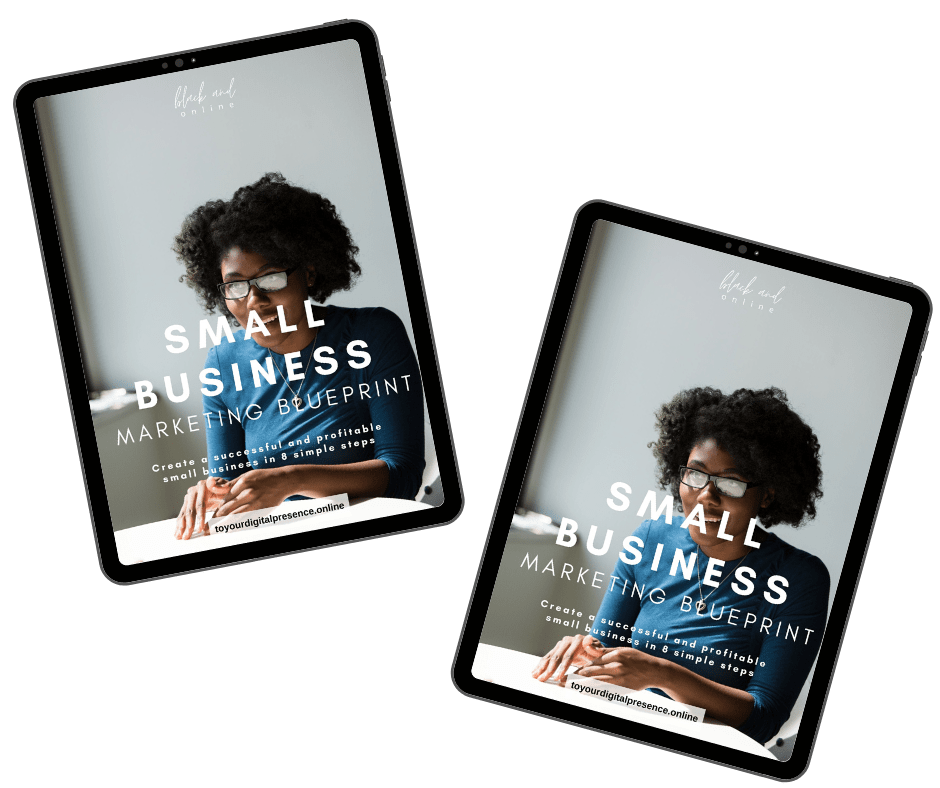
8-Step Marketing Blueprint
If you want to attract ideal prospects, make more client sales and keep your client pipeline filled you need to know how to build a sustainable and profitable online business. Grab the FREE 8-Step Marketing Blueprint that helps you get fast growth ideas for your service, coaching or consulting business.